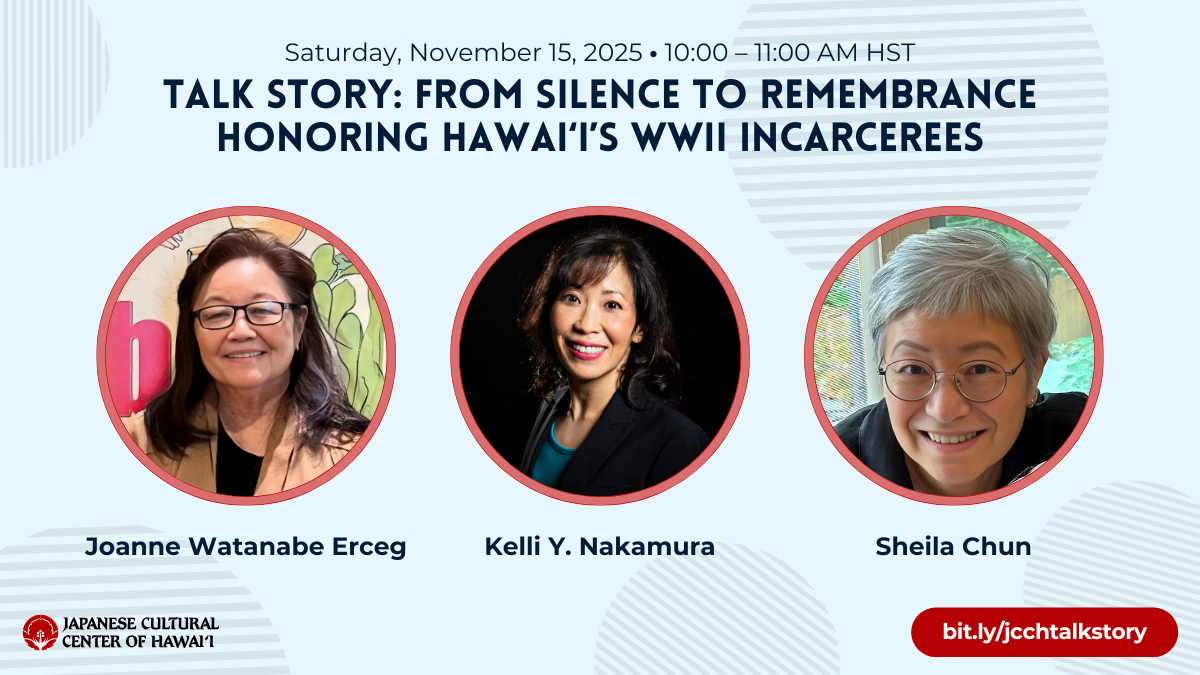Join us for a special talk story at the Japanese Cultural Center of Hawaiʻi to learn about ongoing efforts to memorialize those unjustly imprisoned during World War II.
Watch the Live Stream on YouTube
At a time when historical truth faces erasure and censorship, preserving the stories and records of WWII incarcerees has never been more important. This presentation features three dedicated individuals—Sheila Chun, Joanne Watanabe Erceg, and Kelli Y. Nakamura—who are helping ensure these histories are remembered with accuracy and dignity.
-
Sheila Chun will share insights from her research for the JCCH’s Hawai‘i Internee Database.
-
Joanne Erceg will discuss her pilgrimage to incarceration sites across the country and her contributions to the Ireichō: Book of Names project.
-
Dr. Kelli Nakamura, Professor of History at Kapi‘olani Community College, will highlight her new book, Legacies of Incarceration: The World War II Experience of Hawai‘i’s Japanese.
Discover how these efforts honor the resilience of our elders and ancestors, and how together, we can ensure that their stories will continue to be told for generations to come.
"We are drawing on Japanese and Japanese American cultural traditions of honoring elders and ancestors, not simply through building monuments of remembrance, but monuments to repair the racial karma of America."
Duncan Ryūken Williams,
Irei Project Co-Founder, Soto Zen Buddhist priest, USC Shinso Ito Center Director
To attend in person, RSVP using the link above by Thursday, November 13, 2025. Limited seating is available. Check-in begins at 9:45 AM. JCCH parking validation will be provided to in-person attendees. This presentation will also be livestreamed via the JCCH YouTube channel.
Talk Story Panelists

Joanne Watanabe Erceg is a retired engineer and 4th-generation Japanese American who is currently working on a pilgrimage project to visit World War II sites of Japanese American incarceration. To date, she has visited 101 sites and another 30 related historic places. She supports the Ireichō: Book of Names project by updating and marking names.
Kelli Y. Nakamura, PhD, is a professor of history at Kapi‘olani Community College. Her research interests focus on Japanese and Japanese American history, and she has published articles in the Journal of World History, Amerasia, The Historian, the Pacific Historical Review, and the Hawaiian Journal of History, where she currently serves as a co-editor. She also teaches at the Ethnic Studies and History Department at the University of Hawai‘i at Mānoa, focusing on race relations during World War II. Her new title, Legacies of Incarceration: The World War II Experience of Hawai‘i’s Japanese, is available now.
Sheila H. Chun has an M.A. in History from Indiana University and has been a dedicated volunteer at the JCCH's Tokioka Heritage Resource Center since 2005. She served as managing editor of Family Torn Apart: The Internment Story of the Otokichi Muin Ozaki Family and edited the English translation of Suikei Furuya’s Haisho Tenten. Since 2016, Sheila has contributed to research for the Hawai‘i Internee Database and helped transition it into an accessible online resource.
Resources
The Ireichō: Book of Names is the first comprehensive list of the over 126,000 persons of Japanese ancestry who were unjustly imprisoned in local temporary detention facilities and U.S. Army, Department of Justice (DOJ), Wartime Civil Control Administration (WCCA), and War Relocation Authority (WRA) camps. It is a part of The Irei: National Monument for the WWII Japanese American Incarceration, a multi-faceted project that seeks to address the attempted erasure of those individuals of Japanese ancestry who experienced wartime incarceration by memorializing their names.
The Ireichō: Book of Names is on a national tour and will be in Honolulu at the JCCH in April 2026. Named after the Japanese term for “consoling the spirits,” the Ireichō monument honors both those who have gone before us as well as those who carry on the memories and legacies of forced removal, unjust incarceration, and family separation. Every visitor to the monument is invited to contribute to the creation of the monument by marking one or more names in the Ireichō with a blue hanko stamp. For many camp survivors and descendants, leaving this mark has been a way to honor the personhood of a family member who suffered the indignities and losses of the wartime incarceration.
The Hawai‘i Internee Database, produced by the Japanese Cultural Center of Hawai‘i, is an online searchable directory of those of Japanese ancestry who were arrested and confined in the Territory of Hawai‘i during World War II. Government records, military documents, internee memoirs, and historical publications have been rigorously cross-checked to confirm accuracy. The database identifies internee names, their place of residence in 1941, their occupation, the names of family members who were also incarcerated, and the name(s) of site(s) where they were imprisoned. Photographs, information about artifacts, and oral history transcripts are also referenced.
Now available for purchase at the JCCH Gift Shop: Legacies of Incarceration: The World War II Experience of Hawai‘i’s Japanese provides a holistic view of the incarceration experience of Hawaiʻiʻs Japanese by exploring the factors that shaped the circumstances of confinement on each island before, during, and after World War II. This book examines residents’ experiences on Hawai‘i Island, Maui, Moloka‘i, Lāna‘i, Kaua‘i, and O‘ahu, expanding beyond an Oʻahu-centric, urban focus to highlight the community impact of incarceration. It addresses the specific conditions and challenges inmates encountered on each island before they were released, transferred to O‘ahu, and sent either to Honouliuli or incarceration centers on the American continent.
Notably, the prewar influence of the United States military and the plantations shaped the evolution of the distinctive and inconsistent incarceration policies across the islands, resulting in a diversity of inmate experiences. The author’s archival research, in both English and Japanese, reveals these varied perspectives. As its title suggests, this book ultimately documents the enduring legacies of war that still deeply resonate in various communities within the Islands and beyond, illuminating the impacts of wartime racism.
